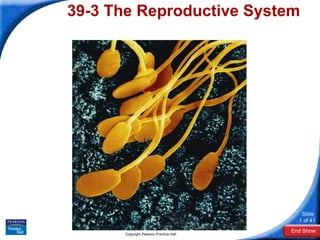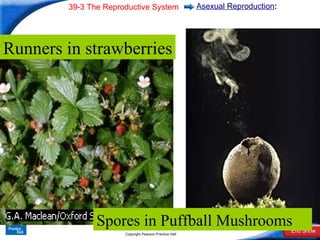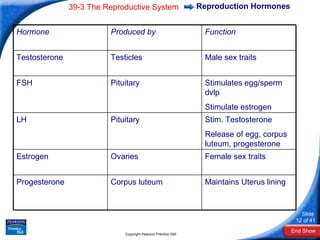Reproductive system ppt
- 1. 39-3Â The Reproductive System Copyright Pearson Prentice Hall
- 2. Asexual examples : Hydra Budding of polyps Copyright Pearson Prentice Hall Regeneration of cut pieces
- 3. Amoeba asexual division Nucleus Copyright Pearson Prentice Hall 2 nd amoeba
- 4. Asexual Reproduction : Copyright Pearson Prentice Hall Runners in strawberries Spores in Puffball Mushrooms
- 5. Sexual Reproduction Copyright Pearson Prentice Hall
- 6. â Joeyâ develops in a Pouch Copyright Pearson Prentice Hall
- 7. Flowering Plants Sexual Reproduction Copyright Pearson Prentice Hall Dry Pollen For sperm
- 8. Ferns Sexual & Asexual Reproduction Copyright Pearson Prentice Hall Sexual & Asexual
- 9. The Male Reproductive System Male Reproductive System Copyright Pearson Prentice Hall Urinary bladder Vas deferens Pubic bone Urethra Penis Seminal vesicle Rectum Prostate gland Bulbourethral gland Scrotum Testis Epididymis
- 10. The Male Reproductive System A sperm cell consists of: a head, which contains the nucleus a midpiece, which contains energy-releasing mitochondria a tail, which propels the cell forward Copyright Pearson Prentice Hall Head Nucleus Midpiece Mitochondria Tail
- 11. Sperm Production (Spermatogenesis) Video Copyright Pearson Prentice Hall
- 12. Reproduction Hormones Copyright Pearson Prentice Hall Hormone Produced by Function Testosterone Testicles Male sex traits FSH Pituitary Stimulates egg/sperm dvlp Stimulate estrogen LH Pituitary Stim. Testosterone Release of egg, corpus luteum, progesterone Estrogen Ovaries Female sex traits Progesterone Corpus luteum Maintains Uterus lining
- 13. Sperm Production Regulation See p. 53 Copyright Pearson Prentice Hall
- 14. The Female Reproductive System Female Reproductive System Copyright Pearson Prentice Hall Fallopian tube Ovary Uterus Urinary bladder Pubic bone Urethra Vagina Rectum Cervix
- 15. The Menstrual Cycle The Menstrual Cycle The menstrual cycle is controlled by internal feedback mechanisms between the reproductive system and the endocrine system. The cycle takes an average of 28 days. Copyright Pearson Prentice Hall
- 16. The Menstrual Cycle Copyright Pearson Prentice Hall Ovulation
- 17. Copyright Pearson Prentice Hall
Editor's Notes
- #2: Photo Credit: ÂĐDavid M. Phillips/Photo Researchers Inc.
- #10: The main structures of the male reproductive system produce and deliver sperm. The main organs of the male reproductive system are the testes. The testes are located in an external sac called the scrotum. The scrotum is located outside the body cavity, where it is between 1 and 3 degrees cooler than normal body temperature. The lower temperature helps sperm development. The testes are located in an external sac called the scrotum. The scrotum is located outside the body cavity, where it is between 1 and 3 degrees cooler than normal body temperature. The lower temperature helps sperm development. Within each testis are clusters of hundreds of tiny tubules called seminiferous tubules . The seminiferous tubules are tightly coiled and twisted together. Sperm are produced in the seminiferous tubules. Sperm produced in the seminiferous tubules move into the epididymis , where they mature and are stored. From there, sperm move into a tube called the vas deferens , which extends up from the scrotum into the abdominal cavity. This merges with the urethra , the tube that leads to the outside of the body through the penis . Glands lining the reproductive tract produce seminal fluid. Seminal fluid nourishes sperm and protects them from the acidity of the female reproductive tract. The combination of sperm and seminal fluid is called semen.
- #11: The sperm is the male gamete, or sex cell.
- #15: The main function of the female reproductive system is to produce ova. The ovaries are the main organs of the female reproductive system. Egg Development Each ovary contains about 400,000 primary follicles , which are clusters of cells surrounding a single egg. The follicle helps an egg mature for release into the reproductive tract, where it can be fertilized. Eggs develop within their follicles. When a follicle has matured, its egg is released in a process called ovulation . The follicle breaks open, and the egg is swept from the ovary into one of the two Fallopian tubes . While in the Fallopian tube, an egg can be fertilized. After a few days, the egg passes from the Fallopian tube into the uterus . If the egg is not fertilized it passes through the cervix, and finally out of the vagina . The vagina leads to the outside of the body.
- #17: The menstrual cycle is divided into four phases. Notice the changes in hormone levels in the blood, the development of the follicle, and the changes in the uterine lining during the menstrual cycle.

















